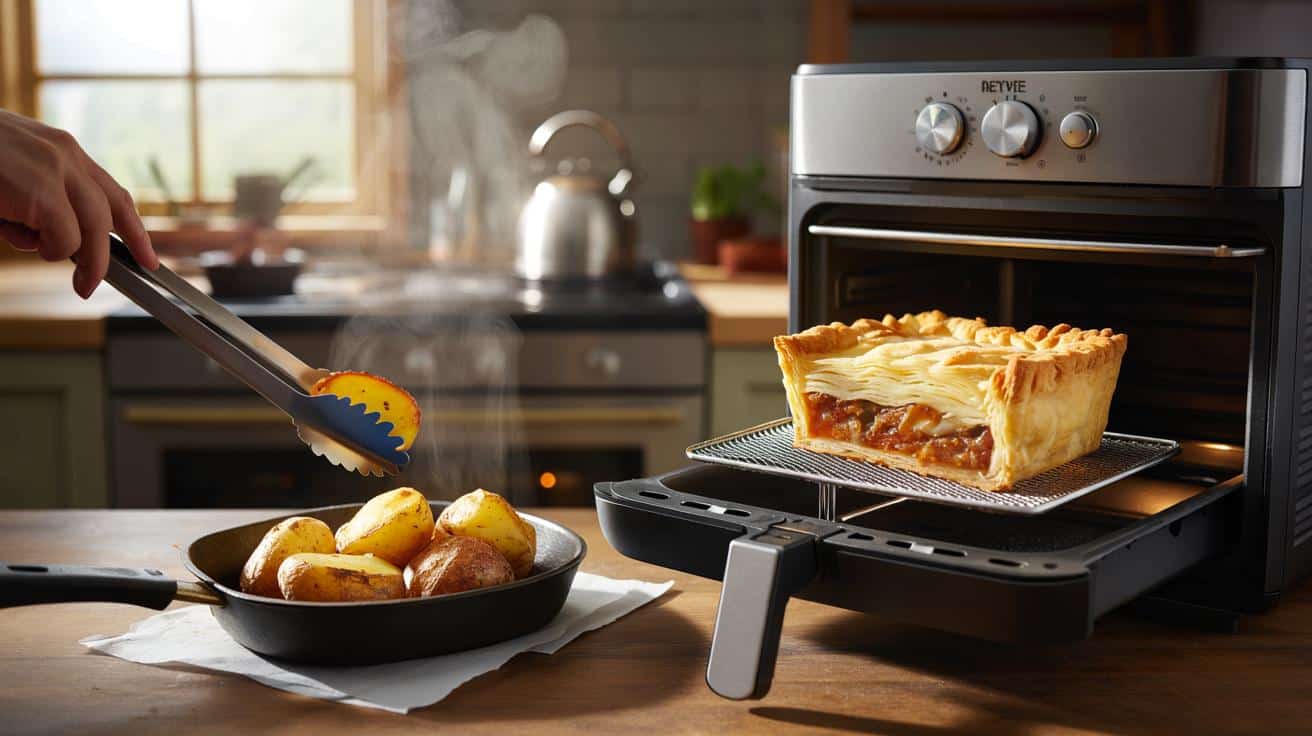The crust goes limp, the spuds turn waxy, and you eye the energy meter like it’s judging you. There’s a way to bring back that just-baked snap without blasting the oven for half an hour. It’s simpler than you think, and kinder on your bill.
It was late on a Sunday. The roast tin sat cold on the hob, a wedge of steak pie glinting under cling film like treasure you forgot to bury. My partner flicked the oven on out of habit, then sighed at the red glow on the smart meter. The air felt tired with gravy and good intentions. *I still think about that pie the next day.*
Steam hugged the window, a telltale of dinner gone. I reached for the kettle instead of the oven dial, slid the pie to the air fryer with a rack, and gave the roasties a scant spritz. The kitchen woke up with a whispery crunch, not a blast. A minute later, the pastry sang when the knife met it. I thought about the rules of heat, and a way through the leftovers maze. Then I did something small that changed everything.
The science of crisp vs comfort
Leftovers go wrong because water moves to all the places you don’t want it. Pastry wants dry air to stay flaky; fillings want gentle steam so they don’t split. Potatoes need their surface to dehydrate again, not stew in their own breath. Use dry heat for crust and gentle steam for the middle.
Here’s a picture you’ll know. It’s Monday lunch, you’re hungry, and the microwave is staring. Zap a pie slice and the pastry slumps like wet cardboard. Go full oven and your meter pings for 15 minutes just to reheat one plate. A reader in Leeds sent me her fix: 30 seconds in the microwave for the pie’s core, then 3–4 minutes in a cold-start air fryer to re-crisp. Her roasties? Tossed onto a hot dry pan for two minutes, then finished in the air fryer basket. She said it felt like a magic trick, only quieter on the bill.
Heat has jobs. Conduction warms the middle. Convection dries and crisps the outside. Steam relaxes starches so they can soften without turning gluey, while higher, drier air finishes the crunch. Think layers: a touch of steam for the heart, arid air for the crust. Once you see those roles, you start mixing tools. A kettle for a wisp of moisture. A microwave’s quick pulse for the centre. An air fryer or oven’s moving air to bring back the bite. That’s the map.
The best reheat routines for pies and roasties
Here’s a method that keeps flavour, saves energy, and respects texture. For a slice of pie from the fridge: let it sit on the counter for five minutes. Give the filling a head start with 20–30 seconds in the microwave. Move it to an air fryer on a rack, cold-start at 160°C for 3 minutes, then 190°C for 1–2 minutes to finish the top. If you’re oven-only, pop the slice on a pre-heated tray, tent very lightly with foil for 5 minutes at 170°C, remove the foil, then 3 minutes at 200°C. The tent is the “steam”, the uncovered blast is the “crisp”.
Roasties need the opposite rhythm: dry the surface first, warm through second. Spread them in a single layer. Heat a dry frying pan until just shy of smoking and roll the potatoes for 60–90 seconds to re-scorch the edges. Slide them to an air fryer at 180°C for 4–6 minutes. No pan? Cold-start the air fryer with a teaspoon of oil and a lick of salt. Don’t crowd them. A little space is the difference between shatter and sog.
We’ve all had that moment when you fire up the big oven for two lonely roasties. It’s fine to be practical. Let’s be honest: nobody does that every day. The small-appliance route cuts time and kilowatts, and you can team tools without fuss. Keep pastry out of the microwave except for that tiny centre-warming pulse. Don’t soak roasties in fresh oil; you’re reactivating what’s already there. Avoid stacking, avoid lids on potatoes, and resist blasting from cold to max heat for pies. The middle turns molten before the crust has a chance to crisp. Your senses will tell you when it’s right. The smell shifts. The sound goes from dull to a sandy hiss. That’s the moment.
For foolproof results, think “steam inside, air outside”. Warm the pie’s filling gently, then give the pastry moving air. Dry the roasties first, then heat them through. A chef-baker in Hackney put it this way:
“Heat the crust with air, warm the filling with steam. Swap those jobs and you get sog.”
- Pie slice: 20–30 sec microwave, then 160°C air fryer 3 min + 190°C 1–2 min.
- Whole small pie: 10 min at 150°C in oven or air fryer, then 3–5 min at 190°C. Light foil tent for the first stage.
- Roast potatoes: 1–2 min in a hot dry pan, then 4–6 min in air fryer at 180°C. No crowding.
- Energy tip: cold-start small appliances when the load is small; save preheating for trays full of food.
Leftovers that taste like today
What you’re aiming for isn’t perfection. It’s that little lift that turns leftovers into dinner you’re proud to plate. A kettle’s puff of steam, a cold-start air fryer, a pan’s quick scorch – tiny moves, big payoff. If you cook for one, this is freedom from the tyranny of the full oven. If you feed many, it’s the rhythm that keeps plates moving without the soggy lull. There’s also the quiet win of safety and sense: chill within two hours, reheat once until piping hot, then move on. No guilt, no waste, no limp pastry. Share the plate, share the trick, and pass the roasties while they still whisper.
| Key points | Detail | Reader Interest |
|---|---|---|
| Two-stage heat | Moisture for the middle, dry moving air for the crust | Explains why reheats fail, builds confidence |
| Small-appliance bias | Microwave pulse + air fryer finish beats full-oven for one plate | Saves time and energy without gimmicks |
| Roastie rescue | Pan re-scorch, then brief air fryer to warm through | Brings back shatter-crisp potatoes fast |
FAQ :
- Can I reheat a pie entirely in the microwave?A quick zap will warm the filling, but the pastry slumps. Use 20–30 seconds to heat the core, then finish with dry air in an air fryer or hot oven tray for the snap.
- What’s the best way to keep pastry from going soggy?Keep the pastry in contact with moving hot air. Lift it on a rack, remove foil for the final minutes, and avoid steam trapped under lids once the crust is nearly there.
- Is an air fryer really more energy-efficient than the oven?For small batches, yes. Shorter heat-up and a tiny cavity mean fewer minutes of power. Cold-starts for quick jobs trim usage further, while full ovens make sense only when you’ve got a full tray.
- How do I reheat roast potatoes without drying them out?Re-crisp the outside first in a hot dry pan or basket, then warm through briefly. A light spritz of water in the basket can help the centre settle, but keep the surface dry.
- What about food safety?Cool leftovers within two hours, refrigerate, and reheat once until piping hot throughout. Pies and potatoes hold well for 2–3 days in the fridge; any doubt, bin it rather than risk it.








